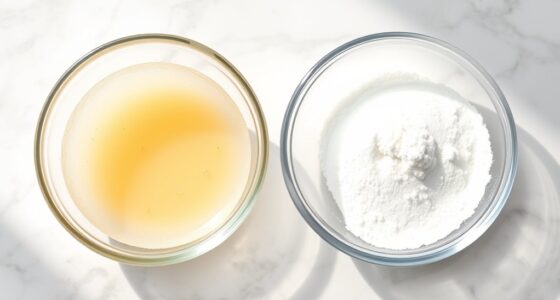In Middle Eastern cooking, sumac and za’atar are essential spices that bring vibrant flavor and cultural depth to dishes. Sumac offers a tangy, lemony brightness that enhances salads, meats, and dips, while za’atar blends herbs, sesame seeds, and sumac for a complex, aromatic seasoning. Both spices are celebrated for their health benefits and versatility, elevating simple ingredients into flavorful staples. To discover more about how these spices shape regional cuisine, keep exploring their uses and traditions.
Key Takeaways
- Sumac provides a tangy, lemony flavor and vibrant color, enhancing salads, meats, and dips in Middle Eastern cuisine.
- Za’atar is a traditional spice blend combining thyme, oregano, marjoram, sesame seeds, and sumac, integral to regional dishes.
- Sumac’s acidity was historically used to add brightness before citrus fruits became widespread.
- Za’atar offers health benefits, including antioxidants and healthy fats from herbs and sesame seeds.
- Both spices are versatile, easily incorporated into various dishes to add flavor, nutrition, and cultural authenticity.

Middle Eastern cooking relies heavily on a vibrant array of spices that transform simple ingredients into flavorful dishes. Among these, sumac and za’atar stand out for their unique flavors and cultural significance. Understanding their history and health benefits can deepen your appreciation and inspire more intentional use in your kitchen. Sumac, with its tangy, lemony flavor, has a rich history dating back thousands of years. Originally cultivated in the Middle East and parts of the Mediterranean, sumac is made from dried, crushed berries of the Rhus plant. Ancient civilizations valued it not only for its flavor but also for its preservative qualities. It was used to add acidity to dishes before the widespread availability of citrus, making it a staple in traditional cuisine. Sumac’s history is intertwined with trade routes and cultural exchanges, spreading its popularity across the region. Today, it’s cherished for its vibrant color and citrusy kick, seamlessly adding brightness to salads, meats, and dips.
Za’atar, on the other hand, is more than just a spice blend; it’s a symbol of Middle Eastern culinary tradition. Its health benefits are well-documented and make it a smart addition to your diet. Packed with herbs like thyme, oregano, and marjoram, along with sesame seeds and sumac, za’atar offers a powerhouse of nutrients. These herbs are rich in antioxidants, which help combat oxidative stress and inflammation. Sesame seeds add healthy fats, magnesium, and calcium, supporting bone health and cardiovascular wellness. Consuming za’atar regularly can boost your immune system, improve digestion, and even promote skin health thanks to its natural anti-inflammatory properties. Its versatility also makes it easy to incorporate into your meals—sprinkle it over hummus, mix it into yogurt, or use it as a seasoning for roasted vegetables and grilled meats.
Frequently Asked Questions
Can Sumac Be Used as a Substitute for Lemon Juice?
Yes, you can use sumac as a lemon flavor substitution in cooking with citrus. It provides a tangy, slightly fruity taste that mimics lemon’s acidity, making it a great alternative in salads, marinades, or dressings. Just sprinkle a small amount and taste as you go, since sumac’s flavor can be more concentrated. It’s a fantastic way to add brightness without using actual lemon juice.
What Are the Health Benefits of Sumac and Za’Atar?
Like a secret weapon, sumac and za’atar boost your health with their antioxidant properties and anti-inflammatory benefits. Sumac helps protect your cells from damage, much like a loyal guardian, while za’atar supports your immune system and reduces inflammation. Incorporating these spices into your meals can promote overall well-being, making your dishes not only flavorful but also nourishing. Embrace their natural power for a healthier, more vibrant life.
How Do I Store Fresh Za’Atar Properly?
To store fresh za’atar properly, you should keep it in an airtight container to preserve its herb flavor and prevent moisture. Place it in the refrigerator to extend its spice shelf life and maintain freshness. Make sure to use it within a week or two for ideal flavor. Proper herb preservation ensures your za’atar stays fragrant, vibrant, and ready to enhance your dishes whenever you need it.
Are There Regional Variations of Za’Atar?
Yes, there are regional variations of za’atar, each reflecting different flavor profiles and traditional preparation methods. In Lebanon, za’atar often features thyme, sumac, and sesame seeds, emphasizing earthy and tangy notes. In Palestine, oregano and marjoram are more prominent, creating a milder flavor. These variations showcase how regional ingredients and culinary traditions influence za’atar’s unique taste, allowing you to enjoy diverse experiences depending on where it’s made.
What Dishes Pair Best With Sumac and Za’Atar?
You’ll love pairing sumac and za’atar with grilled meats and roasted vegetables. Sumac’s tang complements the smoky flavor of grilled chicken or lamb, while za’atar adds a savory, herbal note. Sprinkle these spices on roasted carrots, eggplant, or potatoes for extra depth. They also work well as a seasoning for flatbreads or dips, elevating simple dishes with their vibrant, zesty flavors that enhance your meal’s overall taste.
Conclusion
Now that you’ve discovered the vibrant flavors of sumac and za’atar, aren’t you enthusiastic to bring a taste of Middle Eastern magic to your kitchen? These spices add depth, brightness, and a touch of tradition to any dish. So, why not start experimenting today? With just a sprinkle or two, you’ll transform simple meals into something extraordinary. Ready to spice things up and make your cooking truly unforgettable? The world of flavor is waiting!









